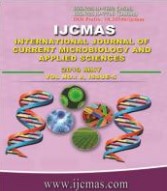


 National Academy of Agricultural Sciences (NAAS)
National Academy of Agricultural Sciences (NAAS)

|
PRINT ISSN : 2319-7692
Online ISSN : 2319-7706 Issues : 12 per year Publisher : Excellent Publishers Email : editorijcmas@gmail.com / submit@ijcmas.com Editor-in-chief: Dr.M.Prakash Index Copernicus ICV 2018: 95.39 NAAS RATING 2020: 5.38 |
A field experiment was conducted at Krishi Vigyan Kendra, Chamarajanagar, University of Agriculture Sciences, GKVK, Bengaluru during Kharif 2016 to develop suitable planting geometry and genotypes for high density planting system of cotton in medium black cotton soil under Southern Dry Zone of Karnataka. The experiment was laid out in split plot design consisting of fifteen treatment combinations involving five planting geometry and three genotypes. The growth and yield of cotton differed significantly due to planting geometry and genotypes under high density planting system. The results of the study revealed that among planting geometry, spacing at 45 x 10 cm recorded significantly taller plant (95.76 cm), Leaf area index at 90 DAS (3.26) and higher seed cotton yield (1589 kg ha 1), whereas planting geometry at 90 x 60 cm resulted higher dry-matter accumulation per plant (149.98 g plant-1), more number of monopodial branches (1.32 plant-1), sympodial branches (16.50 plant-1), more number of bolls per plant (17.83), boll weight (3.36 g) compared to other treatments in the study. Among genotypes tested under different planting geometry DSC-99 produced taller plant (91.14 cm), higher dry-matter accumulation (141.39 g plant-1), more number of monopodial branches (2.90 plant-1), sympodial branches (12.48 plant-1), more number of bolls per plant (14.68), boll weight (3.21 g) compared to ARBC and Suraj genotypes.
 |
 |
 |
 |
 |